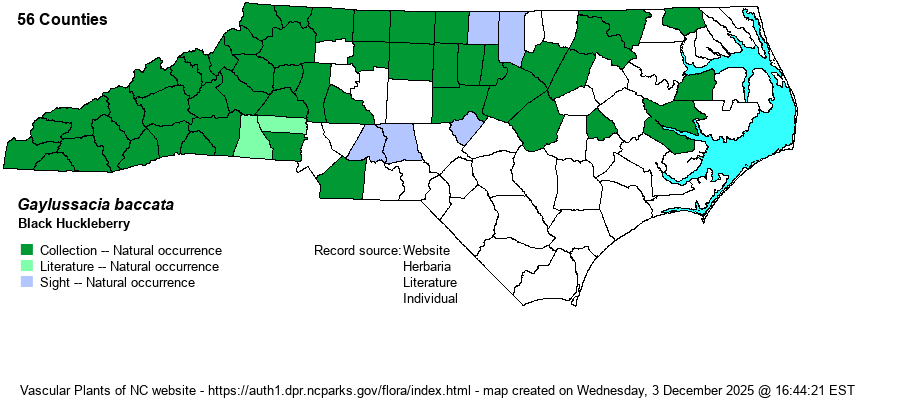| Author | (Wangenheim) K. Koch | |
| Distribution | Throughout the Mountains and Piedmont foothills. Present in most of the remainder of the Piedmont, but of spotty occurrence in the southeastern part of that province. Present over much of the northern Coastal Plain, south to Beaufort, Greene, and Johnston counties, but no confirmed records farther to the south. Likely absent from the far eastern Coastal Plain counties as well.
This is a northern species of huckleberry, being widespread and found across southeastern Canada south through most of NC and eastern TN, sparingly to central AL and western AR.
| |
| Abundance | Common and widespread in the Mountains; frequent to common in most Piedmont counties close to VA. However, it becomes much less numerous farther south, and is mostly uncommon to locally frequent in most of the central and southern Piedmont. It is rare in the northern half of the Coastal Plain, despite being found in practically all counties in VA, even in the southeastern portion of that state. | |
| Habitat | This ericad is typical of dry, acidic forests, often on relatively flat or gently sloping land. It may grow in extensive stands, or mixed with other ericads (such as blueberries). It is not usually found in steep or overly rocky sites. |
| Phenology | Blooms from April into June, but mainly in spring; fruits in July and August. | |
| Identification | This deciduous shrub, along with many other huckleberries and blueberries (genus Vaccinium), can be a difficult species to identify for many biologists and most people of casual interest. It grows from 1-2.5 feet tall, normally in dense stands. It has fairly “normal”, alternate, elliptical and entire leaves, about 2 inches long. It can be identified by the rounded leaf tip and by yellow resin glands on both sides of the leaf. You should pick a leaf and smear both sides on a piece of white paper, to look for a yellow smear. You should also be able to note the stickiness of both sides if you squeeze a leaf. Gaylussacia frondosa has glands only on the underside of the leaf, and its leaves are somewhat more glaucous blue-green than are the medium green of G. baccata. The dangling urn-shaped flowers are usually reddish or pinkish, maybe with a greenish tint, but nowhere close to white. | |
| Taxonomic Comments | None
| |
| Other Common Name(s) | Essentially no others in frequent usage. Crackleberry is rarely used. | |
| State Rank | S5 | |
| Global Rank | G5 | |
| State Status | | |
| US Status | | |
| USACE-agcp | FACU link |
| USACE-emp | FACU link |

